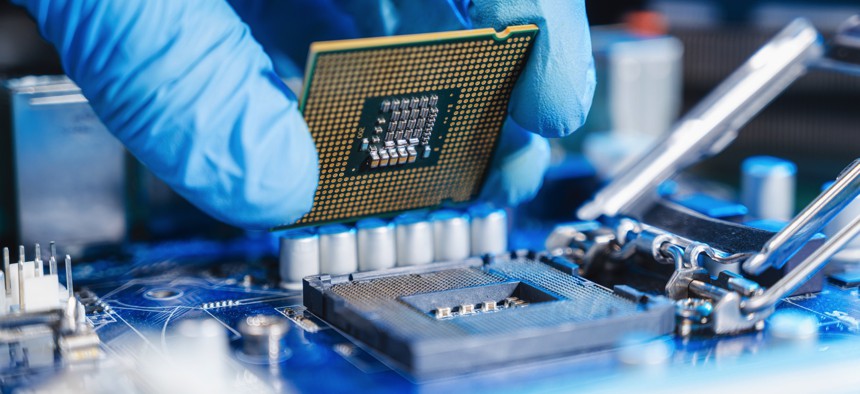Pass the CHIPS Act

Narumon Bowonkitwanchai
COMMENTARY | Two former senior defense and intelligence leaders lay out the case for Congressional action to help the U.S. semiconductor industry.
After 9/11, the country moved swiftly to secure cockpits and improve airport security. Today, we must act with similar urgency to build up America’s ability to design and produce new microchips—starting by passing the CHIPS Act.
Despite America’s impressive semiconductor design and innovation advantages, the U.S. is falling behind in advanced semiconductor production. The U.S. makes just 12 percent of the world's chips while 80 percent come from the Indo-Pacific region. Moreover, global demand is outstripping supply, with chip sales rising up to 17 percent from 2019 to 2021. The world’s semiconductor-makers have responded by making chips at maximum capacity, but the realities of chip production have made those efforts insufficient. In 2021 alone, the chip supply shortage cost the U.S. economy $240 billion.
The high-tech weapons and systems that help give the United States its superiority across every domain of warfare depend on chips. The Javelin anti-tank missile alone, for example, contains more than 200 microelectronic components.
This all creates irresponsible risks for U.S. national security and for American warfighters. We should know: one of us just stepped down as the Deputy Assistant Secretary of Defense for Industrial Policy; the other led the U.S. intelligence community’s assessments on foreign investments in U.S. technology.
The answer is to build more production capacity in the United States, but that’s no quick fix. New semiconductor fabrication plants are technically complex and require extensive capital to fund. McKinsey and Company estimates that building a state-of-the-art fab requires more than three years and $10 billion. Even less-advanced factories come with a hefty price tag: about $5 billion for a 5nm chip fab and $.17 billion for a 10nm one.
The CHIPS Act would reduce US reliance on foreign-made semiconductors. The Atlantic Council estimates that with the CHIPS Act, by 2030, US semiconductor manufacturing would account for about 14 percent of global production; without it, the U.S. would drop to ten percent. But that four percent difference is far greater than the numbers would imply because what the U.S. would be producing is the most advanced chips. To do this, the CHIPS Act provides roughly $52 billion to encourage domestic semiconductor manufacturing.
This investment would provide the necessary down-payment for avoiding technology dependence on foreign chipmakers, curtail inflation of semiconductor prices, and enable a competitive market in the U.S. that takes advantage of our know-how in designing and producing the most advanced chips, especially those at 14 nanometers and below.
Critics argue that the CHIPS Act would distort the market. It might. Lawmakers should strongly consider how to incentivize local development across the segments of the market and avoid picking corporate winners. America’s economic competitiveness has always come from its capacity to harness the power of the market.
But the global semiconductor market is already distorted by a network of foreign competitors who undermine the U.S. ability to compete on production cost–by subsidizing nearly 30 percent of semiconductor revenues. Beijing has already provided more than $160 billion in subsidies to China chip manufacturers. Taiwan's chipmakers are investing $120 billion; the Republic of Korea is giving up to $450 billion in tax credits over the next 10 years; and Japan’s subsidies are designed to enable it to triple its chip production by 2030. The European Union has also committed $48 billion to chip production in order to reduce dependency on foreign firms.
The CHIPS Act, which has passed the Senate and now awaits action by the House, will renew a critical area of American strength, while also creating new opportunities with our allies. Japan, South Korea, Germany, and Taiwan all produce some of the world’s most advanced chips. Dutch lithography technology is currently key to every nation’s production of the smallest-die chips. The push to build global semiconductor resilience is accelerating U.S. efforts to deepen its defense industrial cooperation with our allies and partners. Together with our allies, we can strengthen supply chain resilience, advance our sources of economic strength, and ensure our warfighters have reliable advantages on the battlefield.
Jonathan Panikoff is a Senior Fellow at the Atlantic Council’s Geoeconomics Center and the former Director of the Investment Security Group at the Office of the Director of National Intelligence. Jesse Salazar is recently served in the Biden Administration as the Deputy Assistant Secretary of Defense for Industrial Policy.





